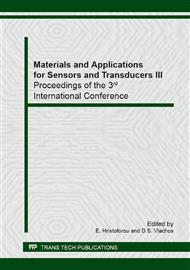[1]
M. Bouvet, A. Pauly, in: Molecular Semiconductor – Based Gas Sensors, edited by C.A. Grimes, E.C. Dickey, M.V. Pishko, volume 6 of The Encyclopedia of Sensors, Stevenson Ranch, American Scientific Publishers (2006).
Google Scholar
[2]
M. Bouvet, V. Parra, C. Locatelli and H. Xiong: J. Porphyrines and Phthalocyanines Vol.13 (2009), p.84.
Google Scholar
[3]
M. Bouvet, G. Guillaud, A. Leroy, A. Maillard, S. Spirkovitch and F.-G. Tournilhac: Sens. Actuators B Vol. 73 (2001), p.63.
DOI: 10.1016/s0925-4005(00)00682-1
Google Scholar
[4]
M. Bouvet: Anal. Bioanal. Chem. Vol. 384 (2006), p.366.
Google Scholar
[5]
B. Crone, A. Dodabalapur, A. Gelperin, L. Torsi, H.E. Katz, A.J. Lovinger and Z. Bao: Appl. Phys. Lett. Vol. 78 (2001), p.2229.
DOI: 10.1063/1.1360785
Google Scholar
[6]
I. Muzikante, V. Parra, R. Dobulans, E. Fonavs, J. Latvels and M. Bouvet: Sensors Vol. 7 (2007), p.2984.
DOI: 10.3390/s7112984
Google Scholar
[7]
M. Bouvet, V. Parra, UPMC and CNRS, PTC/FR. Patent 001325. (2008).
Google Scholar
[8]
V. Parra, J. Brunet, A. Pauly and M. Bouvet: Analyst Vol. 134 (2009), p.1776.
Google Scholar
[9]
P. Wolkoff, G.D. Nielson: Atmo. Env. Vol. 35 (2001), p.4407.
Google Scholar
[10]
B. Brunekreef, S.T. Holgate: The Lancet Vol. 360 (2002), p.1233.
Google Scholar
[11]
B. Timmer, W. Olthuis and A. van den Berg: Sens. Actuators B Vol. 107 (2005), p.666.
Google Scholar
[12]
T. Sizun, M. Bouvet and J.-M. Suisse: Talanta Vol. 97 (2012), p.318.
Google Scholar
[13]
V. Parra, M. Bouvet, J. Brunet, M.L. Rodriguez-Mendez and J.A. De Saja: Thin Solid Films Vol. 516 (2008), p.9012.
Google Scholar
[14]
K. Domansky, D.L. Baldwin, J.W. Grate, T.B. Hall, J. Li, M. Josowicz, and J. Janata: Anal. Chem. Vol. 70 (1998), p.473.
Google Scholar
[15]
S. Christie, E. Scorsone, K. Persaud and F. Kvasnik: Sens. Actuators B Vol. 90 (2003), p.163.
Google Scholar
[16]
M Matsuguchi, A. Okamoto and Y. Sakai: Sens. Actuators B Vol. 94 (2003), p.46.
Google Scholar
[17]
A. Oprea, N. Barsan and U. Weimar: Sens. Actuators B Vol. 111-112 (2005), p.577.
Google Scholar
[18]
D.D Eley, D.J. Hazeldine and T.F. Palmer: J. Chem. Soc. Faraday Trans. Vol. 69 (1973), p.1808.
Google Scholar
[19]
C. Clarisse, M.-T. Riou: Inorg. Chim. Act. Vol. 130 (1987), p.139.
Google Scholar
[20]
M. Bouvet, H. Xiong and V. Parra: Sens. Actuators B Vol. 145 (2010), p.501.
Google Scholar


